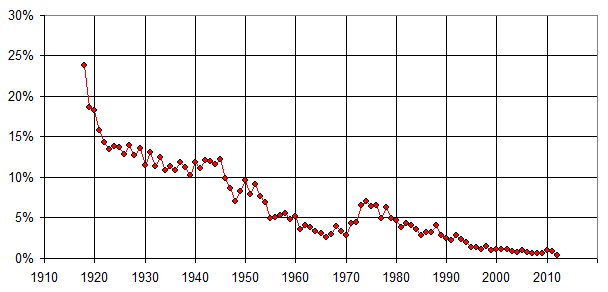Pick any 2012 MLB team. There’s just about a 50-50 chance that that team has a pitcher with a complete-game loss this year. Behold the percentage of all starts that have ended in a CG-loss:

Back in 1918, nearly a quarter of all starts ended in CG losses. That’s because most starts were completed, and a lot of those were on the losing side. It was fairly unusual for a pitcher to get lifted at all.
In 2012, though, the percentage has fallen all the way down to 0.4%, meaning that only about 1 out of every 250 starts ended in a complete game loss. This is the lowest rate in major-league history, even after a bump up in the rate in 2010 and 2011.
One reason why CG losses are so rare is, of course, because complete games themselves are so rare. Only about 3% of all 2012 starts have ended as complete games, just about the lowest rate in history. In 1918, 63% of all starts turned into CGs.
These days, managers follow a pretty strict strategy will bullpens. It’s obvious when they’re ahead–a middle-relief guy in the 7th if needed, then then 8th inning setup guy and the closer for the 9th. But when they are behind, they are just as likely to bring in a middle reliever either mid-inning to try to stem the tide of a rally, or to start the 6th or 7th to prevent a new rally from starting.
Anyway, whenever you see a complete game loss, try to appreciate it. Soon, like the dodo, it may be extinct.
